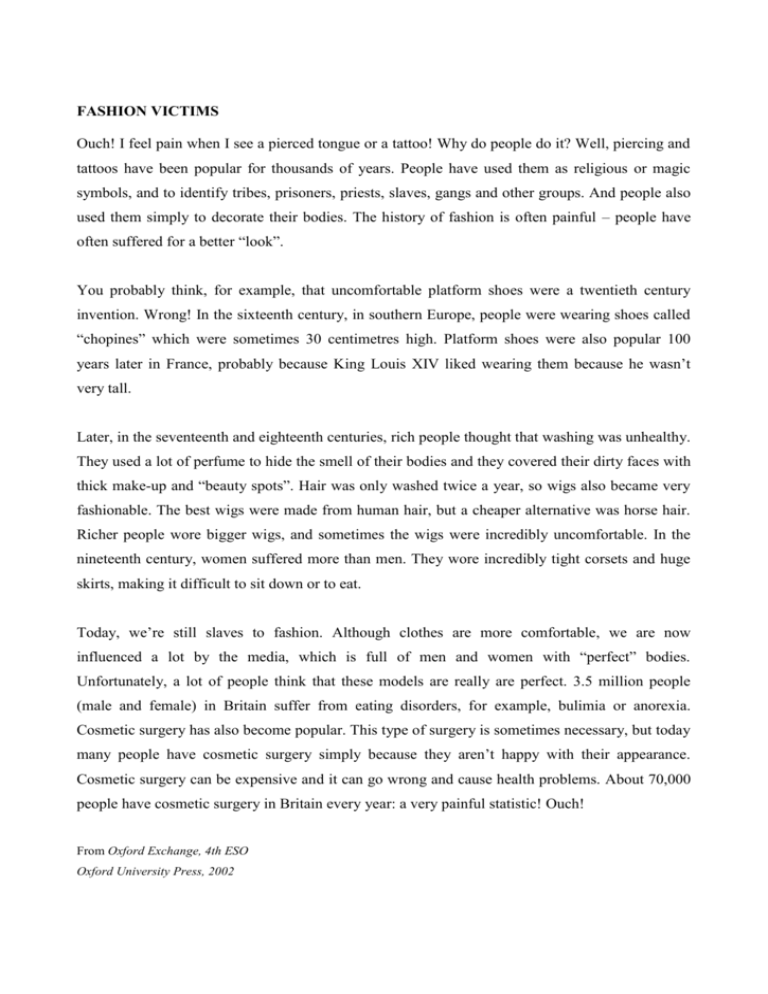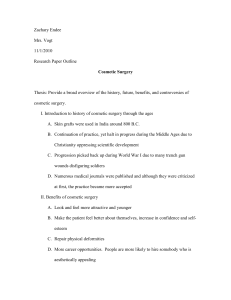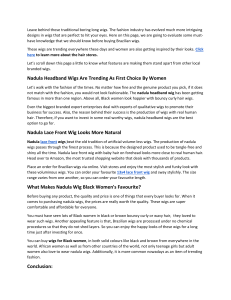FASHION VICTIMS
advertisement

FASHION VICTIMS Ouch! I feel pain when I see a pierced tongue or a tattoo! Why do people do it? Well, piercing and tattoos have been popular for thousands of years. People have used them as religious or magic symbols, and to identify tribes, prisoners, priests, slaves, gangs and other groups. And people also used them simply to decorate their bodies. The history of fashion is often painful – people have often suffered for a better “look”. You probably think, for example, that uncomfortable platform shoes were a twentieth century invention. Wrong! In the sixteenth century, in southern Europe, people were wearing shoes called “chopines” which were sometimes 30 centimetres high. Platform shoes were also popular 100 years later in France, probably because King Louis XIV liked wearing them because he wasn’t very tall. Later, in the seventeenth and eighteenth centuries, rich people thought that washing was unhealthy. They used a lot of perfume to hide the smell of their bodies and they covered their dirty faces with thick make-up and “beauty spots”. Hair was only washed twice a year, so wigs also became very fashionable. The best wigs were made from human hair, but a cheaper alternative was horse hair. Richer people wore bigger wigs, and sometimes the wigs were incredibly uncomfortable. In the nineteenth century, women suffered more than men. They wore incredibly tight corsets and huge skirts, making it difficult to sit down or to eat. Today, we’re still slaves to fashion. Although clothes are more comfortable, we are now influenced a lot by the media, which is full of men and women with “perfect” bodies. Unfortunately, a lot of people think that these models are really are perfect. 3.5 million people (male and female) in Britain suffer from eating disorders, for example, bulimia or anorexia. Cosmetic surgery has also become popular. This type of surgery is sometimes necessary, but today many people have cosmetic surgery simply because they aren’t happy with their appearance. Cosmetic surgery can be expensive and it can go wrong and cause health problems. About 70,000 people have cosmetic surgery in Britain every year: a very painful statistic! Ouch! From Oxford Exchange, 4th ESO Oxford University Press, 2002 READING ACTIVITIES Pre-reading: 1. Guess the word. The teacher shows the following pictures (or words) from the text on the board or using a beamer. The students work in pairs. One student faces the word and describes it (not miming) to their partner, who is facing away from it. Piercing Wig Platforms / Chopines Tattoo Post – reading: Oops! I don’t know the next word! The teacher reads the text out but stops every now and again for the students to say the next word. The teacher can stop before an item of vocabulary such as the ones seen in the pre-reading activity, for instance, or before the names of the centuries, which are a constant in the text as well. He or she can even “play” and change the centuries to check the students remember the exact dates, or the verb tenses (which are mostly in past simple) and the students point out the mistakes and say the correct verb tense. This activity is thought to be applied in the classroom as a game. WRITING 1. Pass the paper. The students write down a word on a piece of paper and then pass it to their partner, who combines it with another word. In this text, we have some examples of adjective + noun (rich people, dirty faces, cosmetic surgery). Student A writes a noun and student B combines it with an adjective. Then they swap back and translate the phrase into their mother tongue. 2. Writing by numbers. I actually tried this activity in my 4th of ESO class and it worked out pretty well. The teacher writes the numbers 1-6 on the board, assigning a category to each number: 1= for 2= introduction 3= conclusion 4= against 5=for 6=against Working in pairs, students are given a dice and they take it in turns to throw the dice and come up with an idea for each number they throw as indicated on the board. They write this idea down. Once they have at least one idea per number, they will have the outline to write their essay or composition, which will be about fashion, following the topic of the text. The six ideas can then be grouped into four paragraphs. USING THE INTERNET The students will review the past simple tense, and for that they can use the following website: http://perso.wanadoo.es/autoenglish/gr.pastsim.i.htm SPEAKING Creating a questionnaire The students create a questionnaire which can be called, for instance, “Are you a fashion victim?” They will think of possible questions using Do you... ?, How often...?, Have you got...?, etc. And three or four possible answers. They will assign a specific number of points to each one and then think of the results. Some possible example questions could be: 1. Do you follow the latest fashion? a) Yes, I love fashion. b) Sometimes, if I like what I see. c) No, I like being different. 2. How often do you buy new clothes? a) Every week! I love going shopping on Saturdays. b) Every four or five months. c) Only when I really need them. 3. Have you got any piercings or tattoos? a) Yes, and I am planning to get more. b) Just a tiny tattoo on my hip. c) No, I am scared of needles! a) answers will be assigned the most points (3-5), b) answers will be worth 2-3 points and c) answers will be assigned the number of less points. Students will work in pairs and ask their partners the questions. Then all the students can discuss the results they got from their partners with the whole class.










